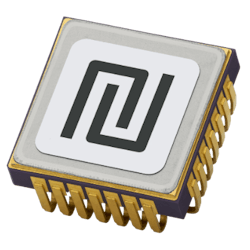OTC 2025: Sensors designed to assist in high-temperature directional drilling operations
By Ariana Hurtado, Editor-in-chief
TDK Group Co.'s subsidiary Tronics Microsystems is active in the field of MEMS (micro-electro-mechanical system) inertial sensors for the oil and gas industry, providing motion sensing, positioning, navigation and condition monitoring of critical assets.
Parent company and European manufacturer TDK's electronics, passive components and sensors are also currently being used at large scale for offshore applications.
Tronics' MEMS inertial sensor and accelerometer—first launched at the Offshore Technology Conference (OTC) in 2024—are used in high-temperature directional drilling applications and MWD tools. The company says the closed-loop sensor’s architecture allows it to operate under high temperature, vibrations and shock conditions during drilling operations.
Pierre Gazull, Tronics' product marketing manager of MEMS inertial sensors, recently chatted with Offshore about this new technology.
Offshore: What is the offshore drilling industry's need for MEMS sensors and accelerometers technology?
Gazull: Directional modules used in bottom-hole assembly to measure inclination during drilling operations have historically relied on quartz accelerometers. Although these components provide excellent levels of accuracy, they tend to demonstrate weaknesses and significant failure rates when being used for extended period of time in harsh temperature and vibration conditions.
MEMS inertial sensors with tactical-grade performance offer a low-SWaP and cost-effective alternative to quartz accelerometers, demonstrating higher robustness in severe conditions and exhibiting high level of stability to ensure precise measurement while drilling and reduce equipment downtime.
Offshore: Can you explain in general how other MEMS technology failed to meet those needs?
Gazull: MEMS accelerometers currently used for drilling guidance are based on analog-centric designs, requiring the integrator to manage complex analog-to-digital conversion on board with a risk to degrade sensor’s performance. In addition, conventional solutions currently available on the market rely on open-loop sensor architecture, exhibiting poor performances under high level of vibrations and shocks and limiting their application case to static measurement only. This strong limitation eliminates the capability to enable MWD [measurement while drilling] applications where continuous inclination measurement is required to maximize productivity.
Offshore: How did the company develop the technology?
Gazull: Tronics Microsystems has a strong track record enabling critical assets operating in demanding environments, such as railway and avionics systems. MEMS inertial sensors that the company delivered for train localization and aircraft flight control applications demonstrate high level of stability and repeatability when exposed to vibrations and shocks; however, their operating temperature range is not as high as the one required by the oil and gas industry. Leveraging its industry-unique and field-proven sensor architecture combining closed-loop sensing, digital output and miniature ceramic package, Tronics has qualified a new high-temperature MEMS accelerometer with stringent reliability testing to provide a digital-centric acceleration sensor able to withstand the harsh conditions faced by downhole drilling tools.
Offshore: What are the high-temperature MEMS accelerometer's capabilities and applications?
Gazull: Tronics’ high-temperature MEMS accelerometer demonstrates excellent bias stability and high resolution over its temperature range. In addition, its closed-loop architecture allows [users] to achieve an excellent level of vibration rectification to enable continuous inclination measurement during drilling operation. With a lifetime of 1,000 hours at high temperatures, this new digital sensor aims at enabling a new generation of precise MWD tools and directional modules, maximizing the productivity of complex and unconventional drilling operations, decreasing the field failure rate compared to quartz accelerometers and simplifying the system integration thanks to its digital-centric electronics architecture.
Offshore: Can you share any additional work planned to put into development and/or additional industry applications the MEMS technology might have beyond those defined in its scope of work?
Gazull: Tactical-grade MEMS accelerometers are being widely adopted by the aerospace, marine, energy and railway markets for positioning, motion control and navigation applications, as a replacement of bulky and expensive legacy sensors such as quartz accelerometers.
Similarly, MEMS gyroscopes are now finding their way into such demanding applications to replace mechanical gyros and fiber-optic gyroscopes. Tronics is currently working on an ultra-low noise MEMS north-seeker gyroscope that can achieve precise azimuth determination (less than 1° accuracy) in a noticeably short amount of time. This kind of sensor will be soon combined with accelerometers into directional modules to provide a miniature full-MEMS drilling guidance solution, able to fit in a reduced cylindrical form-factor and insensitive to magnetic fields contrary to magnetometers. Tronics will spotlight this technology with a live demo on its booth during OTC 2025.
Tronics Microsystems will be exhibiting at booth 2569 at the Offshore Technology Conference (OTC) from May 5-8 in Houston, Texas. In addition, the company will host a live demo of a miniature north-seeking MEMS gyroscope enabling precise azimuth measurement in downhole survey tools.
About the Author
Ariana Hurtado
Editor-in-Chief
With more than a decade of copy editing, project management and journalism experience, Ariana Hurtado is a seasoned managing editor born and raised in the energy capital of the world—Houston, Texas. She currently serves as editor-in-chief of Offshore, overseeing the editorial team, its content and the brand's growth from a digital perspective.
Utilizing her editorial expertise, she manages digital media for the Offshore team. She also helps create and oversee new special industry reports and revolutionizes existing supplements, while also contributing content to Offshore's magazine, newsletters and website as a copy editor and writer.
Prior to her current role, she served as Offshore's editor and director of special reports from April 2022 to December 2024. Before joining Offshore, she served as senior managing editor of publications with Hart Energy. Prior to her nearly nine years with Hart, she worked on the copy desk as a news editor at the Houston Chronicle.
She graduated magna cum laude with a bachelor's degree in journalism from the University of Houston.



